Health Professionals Communication: Patient Scenario Report
VerifiedAdded on 2023/02/01
|8
|2014
|37
Report
AI Summary
This report analyzes communication skills essential for health professionals, focusing on a patient scenario involving a 20-year-old female, Kirra, referred for mood and weight concerns. It emphasizes a person-centered approach, highlighting the importance of genuineness, empathy, and unconditional positive regard in the practitioner-patient relationship. The report details the application of verbal and non-verbal communication cues, including active listening and open questioning, to encourage the patient to share her story. It addresses the significance of socio-cultural factors and ethical considerations, such as patient privacy and autonomy, and the need for interprofessional communication to develop tailored treatment plans. The report also discusses strategies for addressing patient resistance to change, such as motivational interviewing and questioning techniques. Ultimately, the report underscores the critical role of a sound nurse-patient relationship in achieving positive health outcomes and the need to navigate challenges related to age, ethical concerns, and interprofessional collaboration.
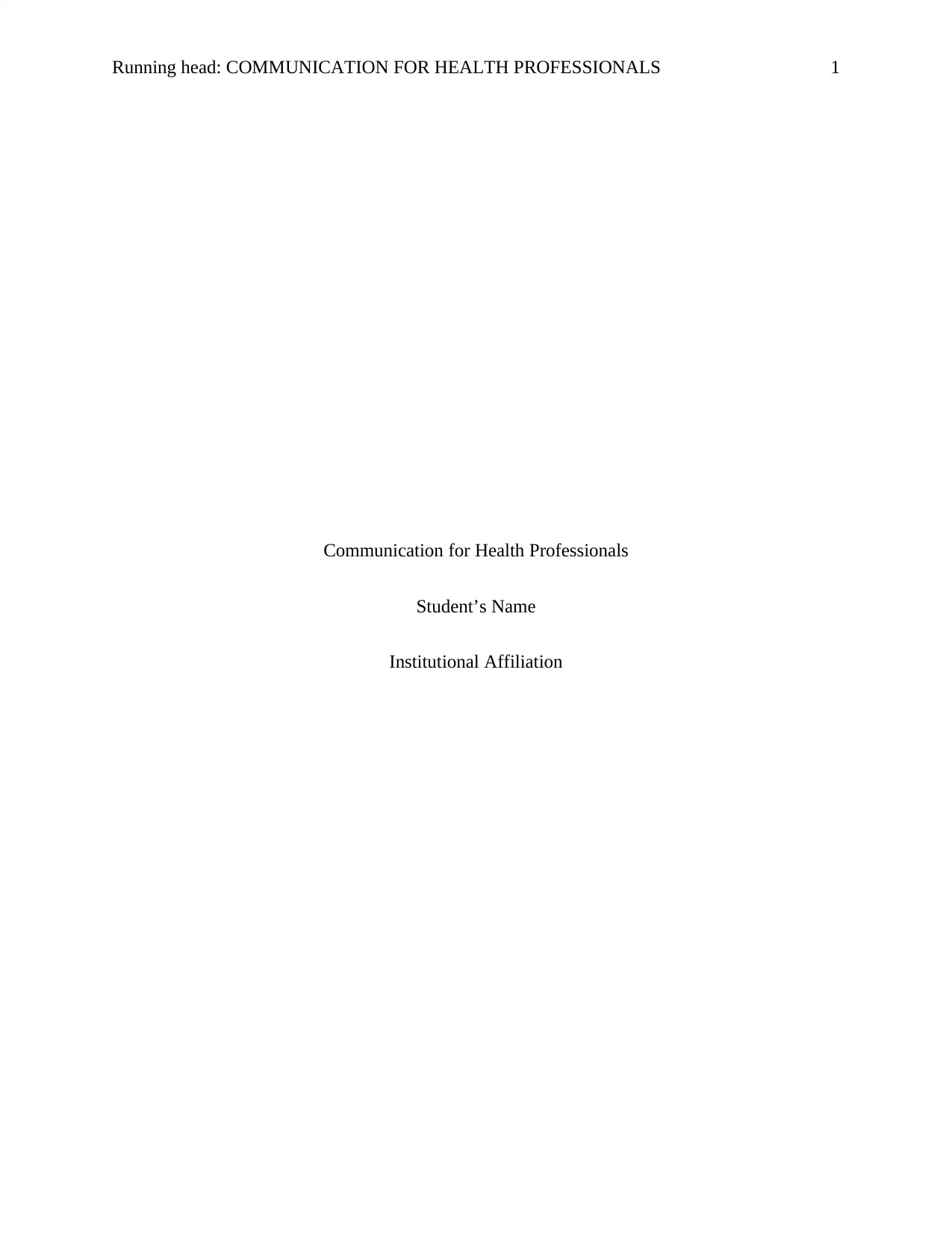
Running head: COMMUNICATION FOR HEALTH PROFESSIONALS 1
Communication for Health Professionals
Student’s Name
Institutional Affiliation
Communication for Health Professionals
Student’s Name
Institutional Affiliation
Paraphrase This Document
Need a fresh take? Get an instant paraphrase of this document with our AI Paraphraser
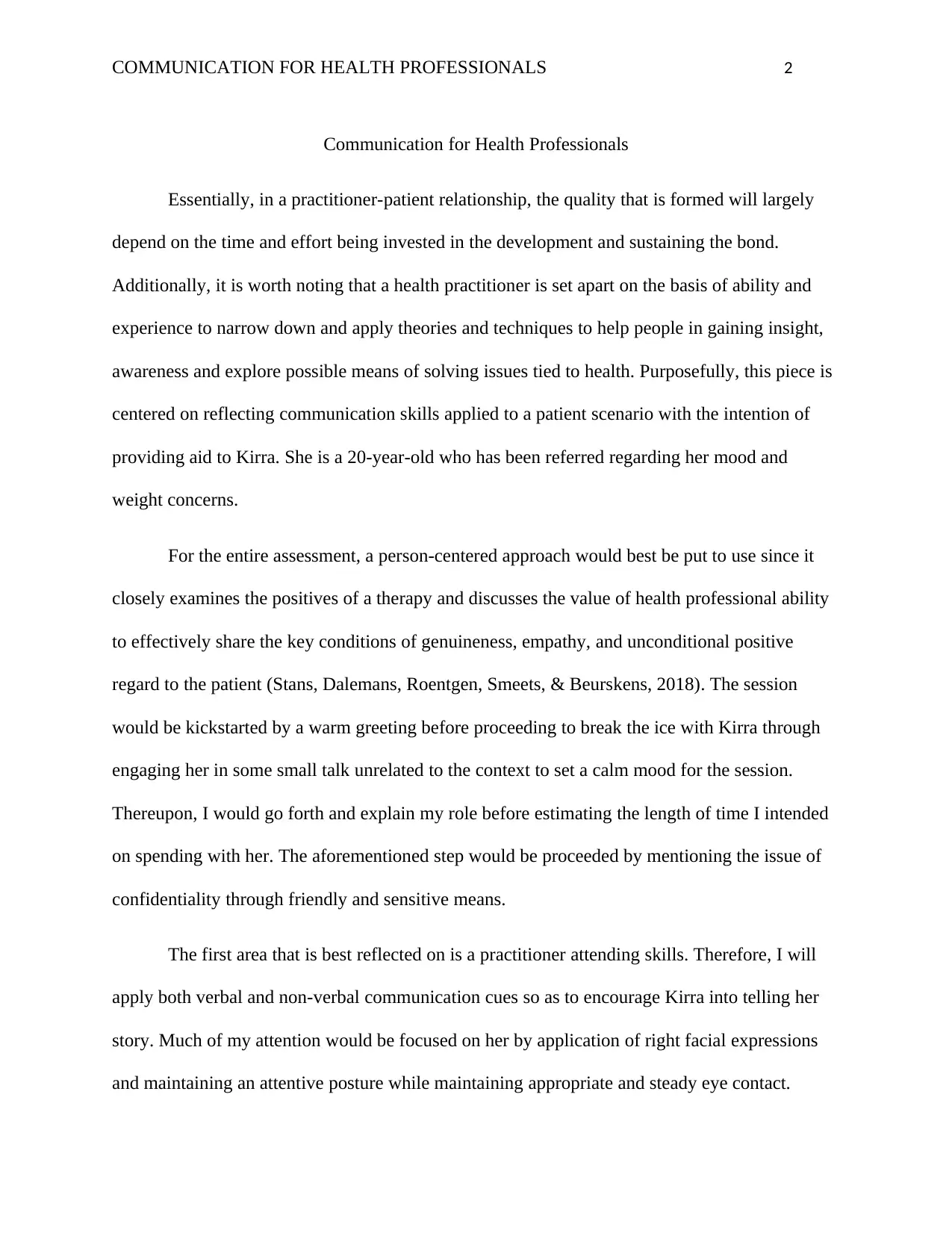
COMMUNICATION FOR HEALTH PROFESSIONALS 2
Communication for Health Professionals
Essentially, in a practitioner-patient relationship, the quality that is formed will largely
depend on the time and effort being invested in the development and sustaining the bond.
Additionally, it is worth noting that a health practitioner is set apart on the basis of ability and
experience to narrow down and apply theories and techniques to help people in gaining insight,
awareness and explore possible means of solving issues tied to health. Purposefully, this piece is
centered on reflecting communication skills applied to a patient scenario with the intention of
providing aid to Kirra. She is a 20-year-old who has been referred regarding her mood and
weight concerns.
For the entire assessment, a person-centered approach would best be put to use since it
closely examines the positives of a therapy and discusses the value of health professional ability
to effectively share the key conditions of genuineness, empathy, and unconditional positive
regard to the patient (Stans, Dalemans, Roentgen, Smeets, & Beurskens, 2018). The session
would be kickstarted by a warm greeting before proceeding to break the ice with Kirra through
engaging her in some small talk unrelated to the context to set a calm mood for the session.
Thereupon, I would go forth and explain my role before estimating the length of time I intended
on spending with her. The aforementioned step would be proceeded by mentioning the issue of
confidentiality through friendly and sensitive means.
The first area that is best reflected on is a practitioner attending skills. Therefore, I will
apply both verbal and non-verbal communication cues so as to encourage Kirra into telling her
story. Much of my attention would be focused on her by application of right facial expressions
and maintaining an attentive posture while maintaining appropriate and steady eye contact.
Communication for Health Professionals
Essentially, in a practitioner-patient relationship, the quality that is formed will largely
depend on the time and effort being invested in the development and sustaining the bond.
Additionally, it is worth noting that a health practitioner is set apart on the basis of ability and
experience to narrow down and apply theories and techniques to help people in gaining insight,
awareness and explore possible means of solving issues tied to health. Purposefully, this piece is
centered on reflecting communication skills applied to a patient scenario with the intention of
providing aid to Kirra. She is a 20-year-old who has been referred regarding her mood and
weight concerns.
For the entire assessment, a person-centered approach would best be put to use since it
closely examines the positives of a therapy and discusses the value of health professional ability
to effectively share the key conditions of genuineness, empathy, and unconditional positive
regard to the patient (Stans, Dalemans, Roentgen, Smeets, & Beurskens, 2018). The session
would be kickstarted by a warm greeting before proceeding to break the ice with Kirra through
engaging her in some small talk unrelated to the context to set a calm mood for the session.
Thereupon, I would go forth and explain my role before estimating the length of time I intended
on spending with her. The aforementioned step would be proceeded by mentioning the issue of
confidentiality through friendly and sensitive means.
The first area that is best reflected on is a practitioner attending skills. Therefore, I will
apply both verbal and non-verbal communication cues so as to encourage Kirra into telling her
story. Much of my attention would be focused on her by application of right facial expressions
and maintaining an attentive posture while maintaining appropriate and steady eye contact.
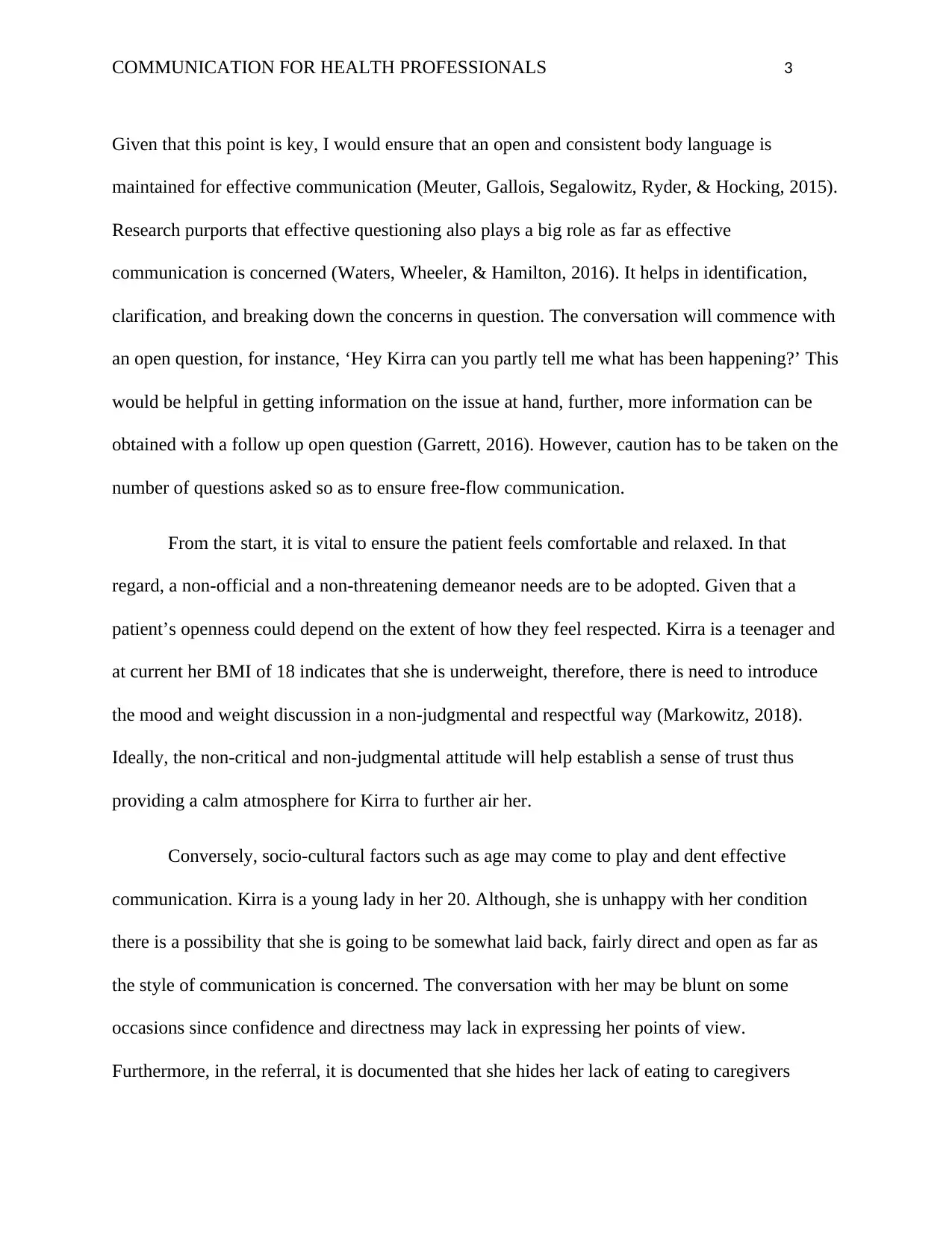
COMMUNICATION FOR HEALTH PROFESSIONALS 3
Given that this point is key, I would ensure that an open and consistent body language is
maintained for effective communication (Meuter, Gallois, Segalowitz, Ryder, & Hocking, 2015).
Research purports that effective questioning also plays a big role as far as effective
communication is concerned (Waters, Wheeler, & Hamilton, 2016). It helps in identification,
clarification, and breaking down the concerns in question. The conversation will commence with
an open question, for instance, ‘Hey Kirra can you partly tell me what has been happening?’ This
would be helpful in getting information on the issue at hand, further, more information can be
obtained with a follow up open question (Garrett, 2016). However, caution has to be taken on the
number of questions asked so as to ensure free-flow communication.
From the start, it is vital to ensure the patient feels comfortable and relaxed. In that
regard, a non-official and a non-threatening demeanor needs are to be adopted. Given that a
patient’s openness could depend on the extent of how they feel respected. Kirra is a teenager and
at current her BMI of 18 indicates that she is underweight, therefore, there is need to introduce
the mood and weight discussion in a non-judgmental and respectful way (Markowitz, 2018).
Ideally, the non-critical and non-judgmental attitude will help establish a sense of trust thus
providing a calm atmosphere for Kirra to further air her.
Conversely, socio-cultural factors such as age may come to play and dent effective
communication. Kirra is a young lady in her 20. Although, she is unhappy with her condition
there is a possibility that she is going to be somewhat laid back, fairly direct and open as far as
the style of communication is concerned. The conversation with her may be blunt on some
occasions since confidence and directness may lack in expressing her points of view.
Furthermore, in the referral, it is documented that she hides her lack of eating to caregivers
Given that this point is key, I would ensure that an open and consistent body language is
maintained for effective communication (Meuter, Gallois, Segalowitz, Ryder, & Hocking, 2015).
Research purports that effective questioning also plays a big role as far as effective
communication is concerned (Waters, Wheeler, & Hamilton, 2016). It helps in identification,
clarification, and breaking down the concerns in question. The conversation will commence with
an open question, for instance, ‘Hey Kirra can you partly tell me what has been happening?’ This
would be helpful in getting information on the issue at hand, further, more information can be
obtained with a follow up open question (Garrett, 2016). However, caution has to be taken on the
number of questions asked so as to ensure free-flow communication.
From the start, it is vital to ensure the patient feels comfortable and relaxed. In that
regard, a non-official and a non-threatening demeanor needs are to be adopted. Given that a
patient’s openness could depend on the extent of how they feel respected. Kirra is a teenager and
at current her BMI of 18 indicates that she is underweight, therefore, there is need to introduce
the mood and weight discussion in a non-judgmental and respectful way (Markowitz, 2018).
Ideally, the non-critical and non-judgmental attitude will help establish a sense of trust thus
providing a calm atmosphere for Kirra to further air her.
Conversely, socio-cultural factors such as age may come to play and dent effective
communication. Kirra is a young lady in her 20. Although, she is unhappy with her condition
there is a possibility that she is going to be somewhat laid back, fairly direct and open as far as
the style of communication is concerned. The conversation with her may be blunt on some
occasions since confidence and directness may lack in expressing her points of view.
Furthermore, in the referral, it is documented that she hides her lack of eating to caregivers
⊘ This is a preview!⊘
Do you want full access?
Subscribe today to unlock all pages.

Trusted by 1+ million students worldwide

COMMUNICATION FOR HEALTH PROFESSIONALS 4
(Moore, Rivera, Bravo-Soto, Olivares, & Lawrie, 2018). This can be dealt with through constant
friendly engagement that could instill confidence to freely speak. Additionally, when it comes to
health communication, ethical considerations also come to play. Issues tied to ethics are firmly
embedded in health communication pursuits when it comes to influencing individuals’ health-
related behaviors and beliefs (Ludolph & Schulz, 2015). For Kirra’s case, some of the ethical
concerns that may arise relate to infringement on her privacy and her right to choose and
autonomy given that she hides her lack of eating. The chosen health interventions may have
psychological effects on the overall well being of the patient since they are likely to deal with
personal choice (Katz & Peberdy, 2015). Another particular concern that may arise may be tied
to personal responsibility. There may be concerns regarding whether the chosen interventions
may invariably put the burden of being of sound health to Kirra.
The weight of Kirra’s health situation calls for partnering with the patient and other
practitioners so as to develop a well-tailored plan that can meet the patient’s needs in preparation
for change. Additionally, the patient is likely to gain from a referral to a registered dietitian who
is likely to guide through a structured weight gain program. Ideally, effective interprofessional
communication is a necessity so as to accurately perform a diagnosis after full disclosure of
information by Kirra. Not only would this help in devising an appropriate treatment for the
patient but would also ensure she agrees to it. As the primary practitioner, it is a requirement to
ensure that Kirra wholly understands the extent of her medical condition plus the rationale
behind the treatment (Moini, Moini, Moini, & Moini, 2018). In that case, the patient and the
team of professionals need to ensure they are fully committed to meeting their respective
obligations. However, interprofessional communication among health professionals may be
undermined by a couple of factors. Firstly, the case of differing ideologies may arise via
(Moore, Rivera, Bravo-Soto, Olivares, & Lawrie, 2018). This can be dealt with through constant
friendly engagement that could instill confidence to freely speak. Additionally, when it comes to
health communication, ethical considerations also come to play. Issues tied to ethics are firmly
embedded in health communication pursuits when it comes to influencing individuals’ health-
related behaviors and beliefs (Ludolph & Schulz, 2015). For Kirra’s case, some of the ethical
concerns that may arise relate to infringement on her privacy and her right to choose and
autonomy given that she hides her lack of eating. The chosen health interventions may have
psychological effects on the overall well being of the patient since they are likely to deal with
personal choice (Katz & Peberdy, 2015). Another particular concern that may arise may be tied
to personal responsibility. There may be concerns regarding whether the chosen interventions
may invariably put the burden of being of sound health to Kirra.
The weight of Kirra’s health situation calls for partnering with the patient and other
practitioners so as to develop a well-tailored plan that can meet the patient’s needs in preparation
for change. Additionally, the patient is likely to gain from a referral to a registered dietitian who
is likely to guide through a structured weight gain program. Ideally, effective interprofessional
communication is a necessity so as to accurately perform a diagnosis after full disclosure of
information by Kirra. Not only would this help in devising an appropriate treatment for the
patient but would also ensure she agrees to it. As the primary practitioner, it is a requirement to
ensure that Kirra wholly understands the extent of her medical condition plus the rationale
behind the treatment (Moini, Moini, Moini, & Moini, 2018). In that case, the patient and the
team of professionals need to ensure they are fully committed to meeting their respective
obligations. However, interprofessional communication among health professionals may be
undermined by a couple of factors. Firstly, the case of differing ideologies may arise via
Paraphrase This Document
Need a fresh take? Get an instant paraphrase of this document with our AI Paraphraser
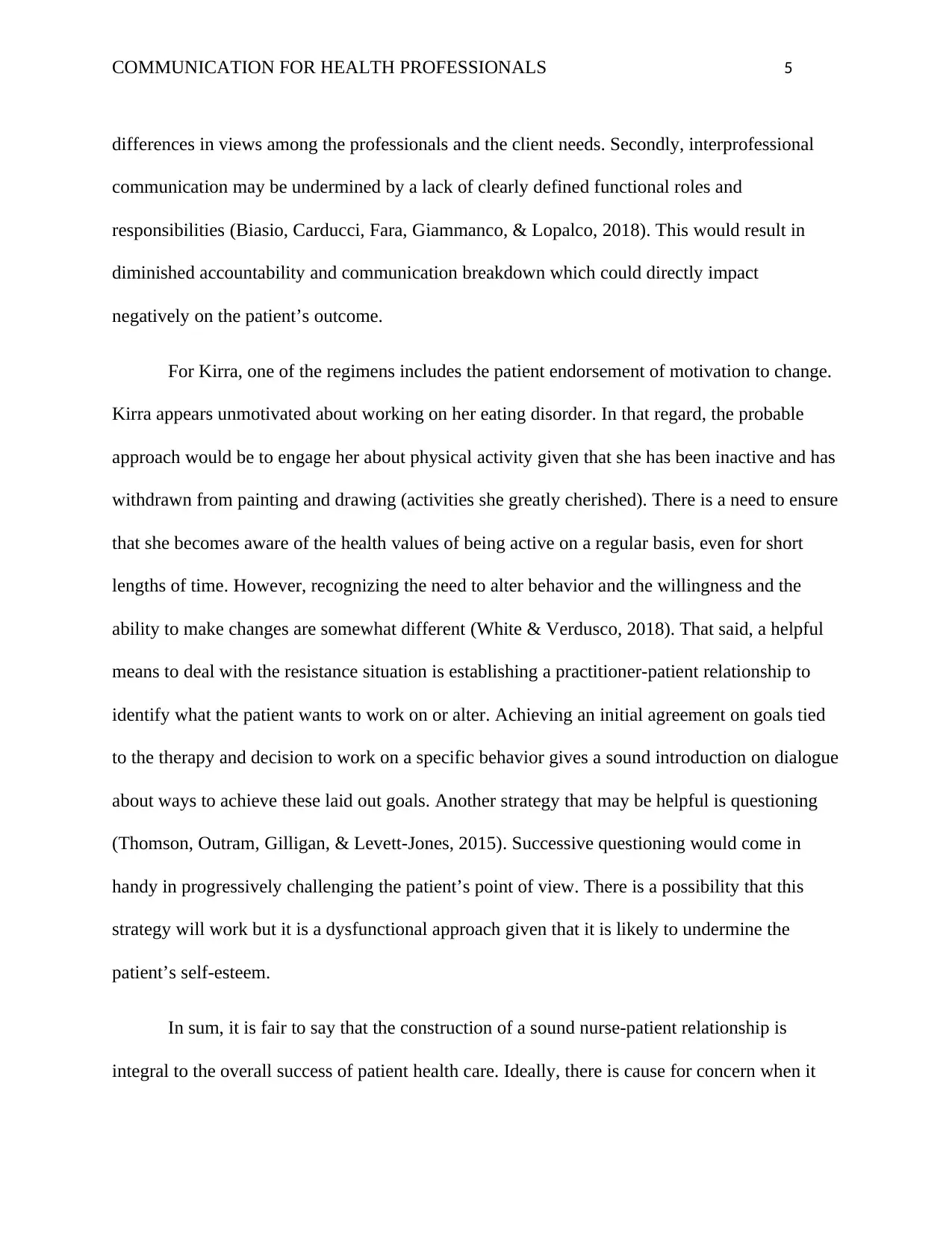
COMMUNICATION FOR HEALTH PROFESSIONALS 5
differences in views among the professionals and the client needs. Secondly, interprofessional
communication may be undermined by a lack of clearly defined functional roles and
responsibilities (Biasio, Carducci, Fara, Giammanco, & Lopalco, 2018). This would result in
diminished accountability and communication breakdown which could directly impact
negatively on the patient’s outcome.
For Kirra, one of the regimens includes the patient endorsement of motivation to change.
Kirra appears unmotivated about working on her eating disorder. In that regard, the probable
approach would be to engage her about physical activity given that she has been inactive and has
withdrawn from painting and drawing (activities she greatly cherished). There is a need to ensure
that she becomes aware of the health values of being active on a regular basis, even for short
lengths of time. However, recognizing the need to alter behavior and the willingness and the
ability to make changes are somewhat different (White & Verdusco, 2018). That said, a helpful
means to deal with the resistance situation is establishing a practitioner-patient relationship to
identify what the patient wants to work on or alter. Achieving an initial agreement on goals tied
to the therapy and decision to work on a specific behavior gives a sound introduction on dialogue
about ways to achieve these laid out goals. Another strategy that may be helpful is questioning
(Thomson, Outram, Gilligan, & Levett-Jones, 2015). Successive questioning would come in
handy in progressively challenging the patient’s point of view. There is a possibility that this
strategy will work but it is a dysfunctional approach given that it is likely to undermine the
patient’s self-esteem.
In sum, it is fair to say that the construction of a sound nurse-patient relationship is
integral to the overall success of patient health care. Ideally, there is cause for concern when it
differences in views among the professionals and the client needs. Secondly, interprofessional
communication may be undermined by a lack of clearly defined functional roles and
responsibilities (Biasio, Carducci, Fara, Giammanco, & Lopalco, 2018). This would result in
diminished accountability and communication breakdown which could directly impact
negatively on the patient’s outcome.
For Kirra, one of the regimens includes the patient endorsement of motivation to change.
Kirra appears unmotivated about working on her eating disorder. In that regard, the probable
approach would be to engage her about physical activity given that she has been inactive and has
withdrawn from painting and drawing (activities she greatly cherished). There is a need to ensure
that she becomes aware of the health values of being active on a regular basis, even for short
lengths of time. However, recognizing the need to alter behavior and the willingness and the
ability to make changes are somewhat different (White & Verdusco, 2018). That said, a helpful
means to deal with the resistance situation is establishing a practitioner-patient relationship to
identify what the patient wants to work on or alter. Achieving an initial agreement on goals tied
to the therapy and decision to work on a specific behavior gives a sound introduction on dialogue
about ways to achieve these laid out goals. Another strategy that may be helpful is questioning
(Thomson, Outram, Gilligan, & Levett-Jones, 2015). Successive questioning would come in
handy in progressively challenging the patient’s point of view. There is a possibility that this
strategy will work but it is a dysfunctional approach given that it is likely to undermine the
patient’s self-esteem.
In sum, it is fair to say that the construction of a sound nurse-patient relationship is
integral to the overall success of patient health care. Ideally, there is cause for concern when it
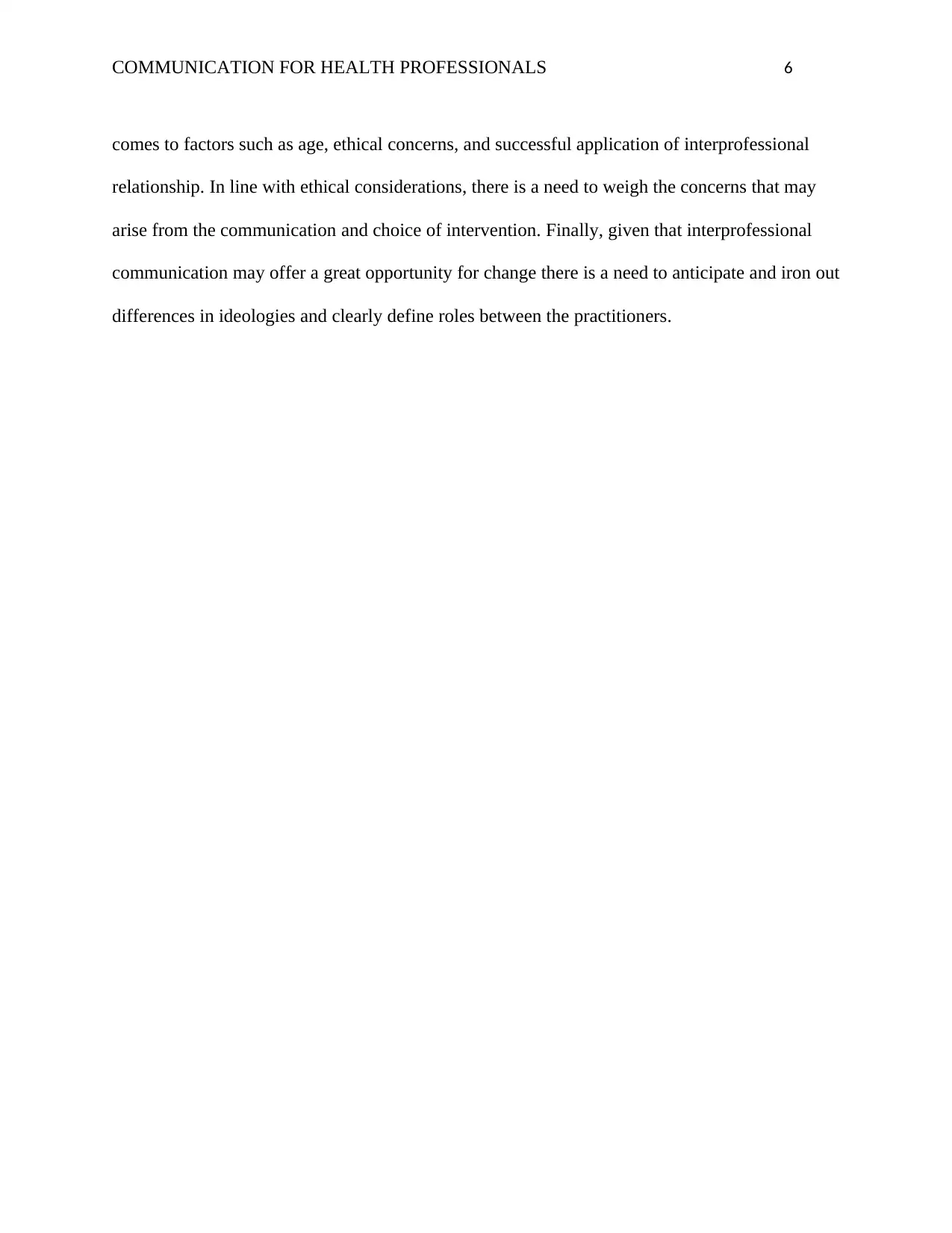
COMMUNICATION FOR HEALTH PROFESSIONALS 6
comes to factors such as age, ethical concerns, and successful application of interprofessional
relationship. In line with ethical considerations, there is a need to weigh the concerns that may
arise from the communication and choice of intervention. Finally, given that interprofessional
communication may offer a great opportunity for change there is a need to anticipate and iron out
differences in ideologies and clearly define roles between the practitioners.
comes to factors such as age, ethical concerns, and successful application of interprofessional
relationship. In line with ethical considerations, there is a need to weigh the concerns that may
arise from the communication and choice of intervention. Finally, given that interprofessional
communication may offer a great opportunity for change there is a need to anticipate and iron out
differences in ideologies and clearly define roles between the practitioners.
⊘ This is a preview!⊘
Do you want full access?
Subscribe today to unlock all pages.

Trusted by 1+ million students worldwide
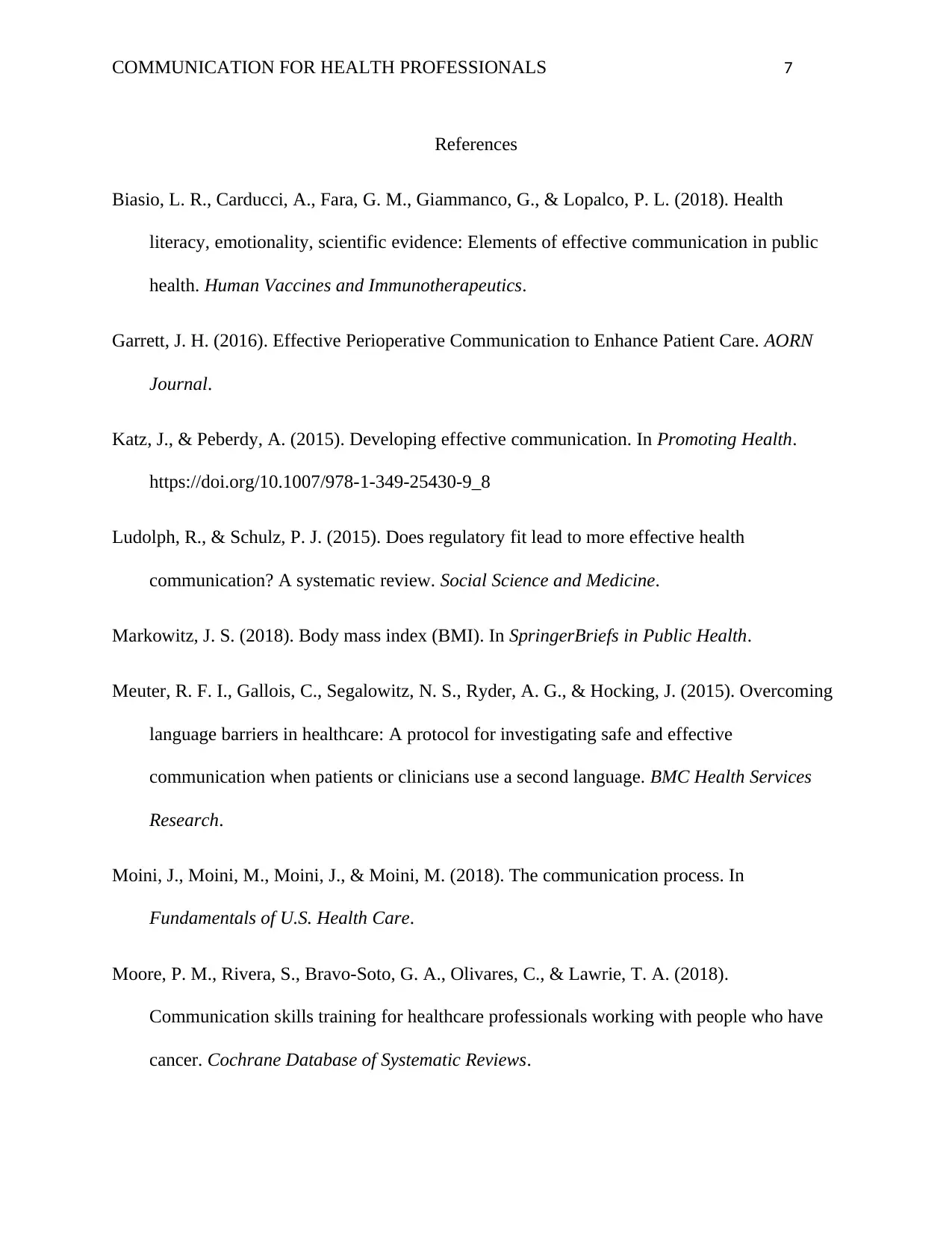
COMMUNICATION FOR HEALTH PROFESSIONALS 7
References
Biasio, L. R., Carducci, A., Fara, G. M., Giammanco, G., & Lopalco, P. L. (2018). Health
literacy, emotionality, scientific evidence: Elements of effective communication in public
health. Human Vaccines and Immunotherapeutics.
Garrett, J. H. (2016). Effective Perioperative Communication to Enhance Patient Care. AORN
Journal.
Katz, J., & Peberdy, A. (2015). Developing effective communication. In Promoting Health.
https://doi.org/10.1007/978-1-349-25430-9_8
Ludolph, R., & Schulz, P. J. (2015). Does regulatory fit lead to more effective health
communication? A systematic review. Social Science and Medicine.
Markowitz, J. S. (2018). Body mass index (BMI). In SpringerBriefs in Public Health.
Meuter, R. F. I., Gallois, C., Segalowitz, N. S., Ryder, A. G., & Hocking, J. (2015). Overcoming
language barriers in healthcare: A protocol for investigating safe and effective
communication when patients or clinicians use a second language. BMC Health Services
Research.
Moini, J., Moini, M., Moini, J., & Moini, M. (2018). The communication process. In
Fundamentals of U.S. Health Care.
Moore, P. M., Rivera, S., Bravo-Soto, G. A., Olivares, C., & Lawrie, T. A. (2018).
Communication skills training for healthcare professionals working with people who have
cancer. Cochrane Database of Systematic Reviews.
References
Biasio, L. R., Carducci, A., Fara, G. M., Giammanco, G., & Lopalco, P. L. (2018). Health
literacy, emotionality, scientific evidence: Elements of effective communication in public
health. Human Vaccines and Immunotherapeutics.
Garrett, J. H. (2016). Effective Perioperative Communication to Enhance Patient Care. AORN
Journal.
Katz, J., & Peberdy, A. (2015). Developing effective communication. In Promoting Health.
https://doi.org/10.1007/978-1-349-25430-9_8
Ludolph, R., & Schulz, P. J. (2015). Does regulatory fit lead to more effective health
communication? A systematic review. Social Science and Medicine.
Markowitz, J. S. (2018). Body mass index (BMI). In SpringerBriefs in Public Health.
Meuter, R. F. I., Gallois, C., Segalowitz, N. S., Ryder, A. G., & Hocking, J. (2015). Overcoming
language barriers in healthcare: A protocol for investigating safe and effective
communication when patients or clinicians use a second language. BMC Health Services
Research.
Moini, J., Moini, M., Moini, J., & Moini, M. (2018). The communication process. In
Fundamentals of U.S. Health Care.
Moore, P. M., Rivera, S., Bravo-Soto, G. A., Olivares, C., & Lawrie, T. A. (2018).
Communication skills training for healthcare professionals working with people who have
cancer. Cochrane Database of Systematic Reviews.
Paraphrase This Document
Need a fresh take? Get an instant paraphrase of this document with our AI Paraphraser
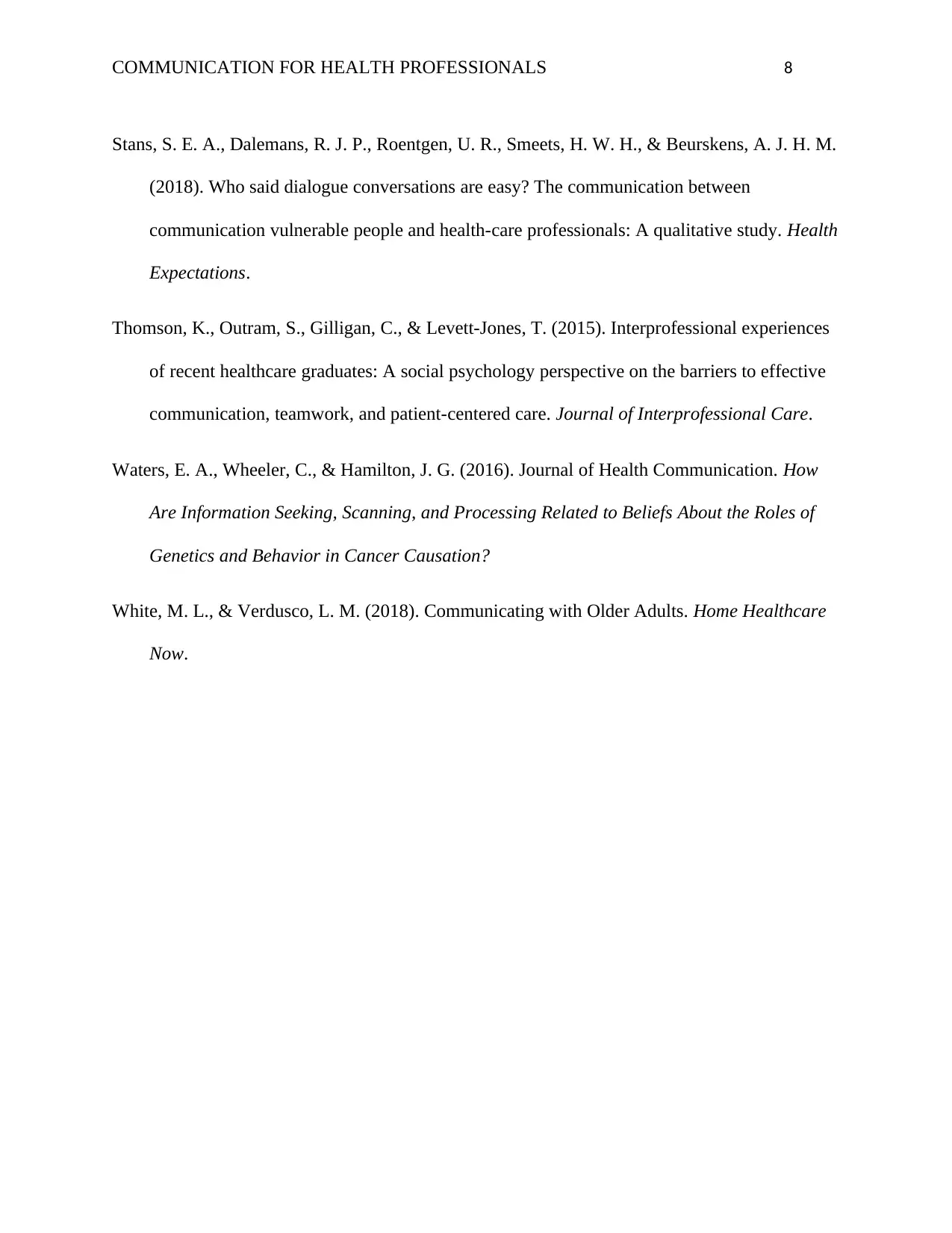
COMMUNICATION FOR HEALTH PROFESSIONALS 8
Stans, S. E. A., Dalemans, R. J. P., Roentgen, U. R., Smeets, H. W. H., & Beurskens, A. J. H. M.
(2018). Who said dialogue conversations are easy? The communication between
communication vulnerable people and health-care professionals: A qualitative study. Health
Expectations.
Thomson, K., Outram, S., Gilligan, C., & Levett-Jones, T. (2015). Interprofessional experiences
of recent healthcare graduates: A social psychology perspective on the barriers to effective
communication, teamwork, and patient-centered care. Journal of Interprofessional Care.
Waters, E. A., Wheeler, C., & Hamilton, J. G. (2016). Journal of Health Communication. How
Are Information Seeking, Scanning, and Processing Related to Beliefs About the Roles of
Genetics and Behavior in Cancer Causation?
White, M. L., & Verdusco, L. M. (2018). Communicating with Older Adults. Home Healthcare
Now.
Stans, S. E. A., Dalemans, R. J. P., Roentgen, U. R., Smeets, H. W. H., & Beurskens, A. J. H. M.
(2018). Who said dialogue conversations are easy? The communication between
communication vulnerable people and health-care professionals: A qualitative study. Health
Expectations.
Thomson, K., Outram, S., Gilligan, C., & Levett-Jones, T. (2015). Interprofessional experiences
of recent healthcare graduates: A social psychology perspective on the barriers to effective
communication, teamwork, and patient-centered care. Journal of Interprofessional Care.
Waters, E. A., Wheeler, C., & Hamilton, J. G. (2016). Journal of Health Communication. How
Are Information Seeking, Scanning, and Processing Related to Beliefs About the Roles of
Genetics and Behavior in Cancer Causation?
White, M. L., & Verdusco, L. M. (2018). Communicating with Older Adults. Home Healthcare
Now.
1 out of 8
Related Documents
Your All-in-One AI-Powered Toolkit for Academic Success.
+13062052269
info@desklib.com
Available 24*7 on WhatsApp / Email
![[object Object]](/_next/static/media/star-bottom.7253800d.svg)
Unlock your academic potential
Copyright © 2020–2025 A2Z Services. All Rights Reserved. Developed and managed by ZUCOL.




